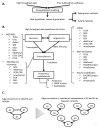Databases and tools for constructing signal transduction networks in cancer
- PMID: 27502015
- PMCID: PMC5319659
- DOI: 10.5483/bmbrep.2017.50.1.135
Databases and tools for constructing signal transduction networks in cancer
Abstract
Traditionally, biologists have devoted their careers to studying individual biological entities of their own interest, partly due to lack of available data regarding that entity. Large, highthroughput data, too complex for conventional processing methods (i.e., "big data"), has accumulated in cancer biology, which is freely available in public data repositories. Such challenges urge biologists to inspect their biological entities of interest using novel approaches, firstly including repository data retrieval. Essentially, these revolutionary changes demand new interpretations of huge datasets at a systems-level, by so called "systems biology". One of the representative applications of systems biology is to generate a biological network from high-throughput big data, providing a global map of molecular events associated with specific phenotype changes. In this review, we introduce the repositories of cancer big data and cutting-edge systems biology tools for network generation, and improved identification of therapeutic targets. [BMB Reports 2017; 50(1): 12-19].
Figures

References
Publication types
MeSH terms
LinkOut - more resources
Full Text Sources
Other Literature Sources

